STATUETTE DE BOUDDHA EN ALLIAGE DE CUIVRE DORÉ TIBET, XIVE SIÈCLE Himalayan Art Resources item no. 4630 19 cm (7 1/2 in.) high Footnotes: A GILT COPPER ALLOY FIGURE OF BUDDHA TIBET, 14TH CENTURY 西藏 十四世紀 銅鎏金佛陀像 Provenance: With Claude de Marteau, Brussels, by 1970s The Buddha Shakyamuni sits in serene equipoise on a double lotus throne with his right hand held in bhumisparsha mudra, the gesture signifying the moment the earth bore witness to his enlightenment. The supreme Awakened One, imagined in perfect form at his moment of enlightenment has attained liberation from the cyclical existence of suffering. His idealized form, reflecting the purity of this moment, illuminates his enlightened physique with the third eye, perfect lotus posture, and raised cranial protuberance. Within this idealization, nevertheless, were cultural and regional styles that adapted and changed as the image of the Buddha moved from India to Nepal and into Tibet. This sculpture of the Buddha heavily borrowed from earlier Indic models which were adopted into the style of the early Malla period (ca 1200-1479) from Nepal. This period coincided with the Yuan dynasty in Tibet, an era ruled by Mongol emperors who supported the growth of Tibetan Buddhism, and the building of monasteries and their decorative programs. Offering their skills and mastery to these designs were craftsman hired from the Kathmandu Valley to build and decorate these religious complexes. Prototypes of the Buddha from Eastern Indian and more specifically the Pala Period style can be recalled in this sculpture in the broad shoulders, the folds of the robes under the crossed ankles and the sharp lines of the eyebrows, as seen in a Bihar Buddha in the Metropolitan Museum of Art, New York (20.58.16). The tapering of the waist and the fishtail folds along the left shoulder reference a more classical Newari style and are featured in another seated Buddha illustrated in von Schroeder, Buddhist Sculptures in Tibet, Vol. 1, Hong Kong, 2001, p. 523, pl. 170C. Moreover, the widened forehead, and delicate, and supple features deviate from the heavily modelled faces of the Pala period, and thus, give way to a gentler depiction of the Buddha in a style more reminiscent of early Malla Period bronzes. An example of this subject coming from this earlier period which sold at Bonhams, New York, 23 September 2020, lot 611 illustrates the prototype of this style which was carried into Tibet. The cold gold applied to the face with the painted details along the rims of the eyes, the arched eyebrows, and lips are indications that this sculpture was either crafted in Nepal and then transported to Tibet or made in Tibet by Newari metalworkers, as painted faces and hair were a customary embellishment for metal sculptures in Tibet. Sculptures such as these existed within a context of transportability, and as such in tracing these intersecting visual idioms across borders illustrates changing styles, but also how essential iconic elements of the Buddha were retained. For further information on this lot please visit Bonhams.com Excellent condition overall, with a faint casting flaw on the proper left forearm at the time of production. Minor nicks and dents mostly throughout the back and proper right shoulder. There is a thin layer of embedded dust and smoky black residue in recessed areas from exposure to temple lamps within the culture. Remains of cold gold to the face, blue pigment to the hair, white and black pigment to the eyes, eyebrows, and pupils, and red pigment to the eyelids and lips. The piece survives with its original gilded base plate. Please contact Sidney Lee (sidney.lee@bonhams.com) for related condition report images.
STATUETTE DE BOUDDHA EN ALLIAGE DE CUIVRE DORÉ TIBET, XIVE SIÈCLE Himalayan Art Resources item no. 4630 19 cm (7 1/2 in.) high Footnotes: A GILT COPPER ALLOY FIGURE OF BUDDHA TIBET, 14TH CENTURY 西藏 十四世紀 銅鎏金佛陀像 Provenance: With Claude de Marteau, Brussels, by 1970s The Buddha Shakyamuni sits in serene equipoise on a double lotus throne with his right hand held in bhumisparsha mudra, the gesture signifying the moment the earth bore witness to his enlightenment. The supreme Awakened One, imagined in perfect form at his moment of enlightenment has attained liberation from the cyclical existence of suffering. His idealized form, reflecting the purity of this moment, illuminates his enlightened physique with the third eye, perfect lotus posture, and raised cranial protuberance. Within this idealization, nevertheless, were cultural and regional styles that adapted and changed as the image of the Buddha moved from India to Nepal and into Tibet. This sculpture of the Buddha heavily borrowed from earlier Indic models which were adopted into the style of the early Malla period (ca 1200-1479) from Nepal. This period coincided with the Yuan dynasty in Tibet, an era ruled by Mongol emperors who supported the growth of Tibetan Buddhism, and the building of monasteries and their decorative programs. Offering their skills and mastery to these designs were craftsman hired from the Kathmandu Valley to build and decorate these religious complexes. Prototypes of the Buddha from Eastern Indian and more specifically the Pala Period style can be recalled in this sculpture in the broad shoulders, the folds of the robes under the crossed ankles and the sharp lines of the eyebrows, as seen in a Bihar Buddha in the Metropolitan Museum of Art, New York (20.58.16). The tapering of the waist and the fishtail folds along the left shoulder reference a more classical Newari style and are featured in another seated Buddha illustrated in von Schroeder, Buddhist Sculptures in Tibet, Vol. 1, Hong Kong, 2001, p. 523, pl. 170C. Moreover, the widened forehead, and delicate, and supple features deviate from the heavily modelled faces of the Pala period, and thus, give way to a gentler depiction of the Buddha in a style more reminiscent of early Malla Period bronzes. An example of this subject coming from this earlier period which sold at Bonhams, New York, 23 September 2020, lot 611 illustrates the prototype of this style which was carried into Tibet. The cold gold applied to the face with the painted details along the rims of the eyes, the arched eyebrows, and lips are indications that this sculpture was either crafted in Nepal and then transported to Tibet or made in Tibet by Newari metalworkers, as painted faces and hair were a customary embellishment for metal sculptures in Tibet. Sculptures such as these existed within a context of transportability, and as such in tracing these intersecting visual idioms across borders illustrates changing styles, but also how essential iconic elements of the Buddha were retained. For further information on this lot please visit Bonhams.com Excellent condition overall, with a faint casting flaw on the proper left forearm at the time of production. Minor nicks and dents mostly throughout the back and proper right shoulder. There is a thin layer of embedded dust and smoky black residue in recessed areas from exposure to temple lamps within the culture. Remains of cold gold to the face, blue pigment to the hair, white and black pigment to the eyes, eyebrows, and pupils, and red pigment to the eyelids and lips. The piece survives with its original gilded base plate. Please contact Sidney Lee (sidney.lee@bonhams.com) for related condition report images.

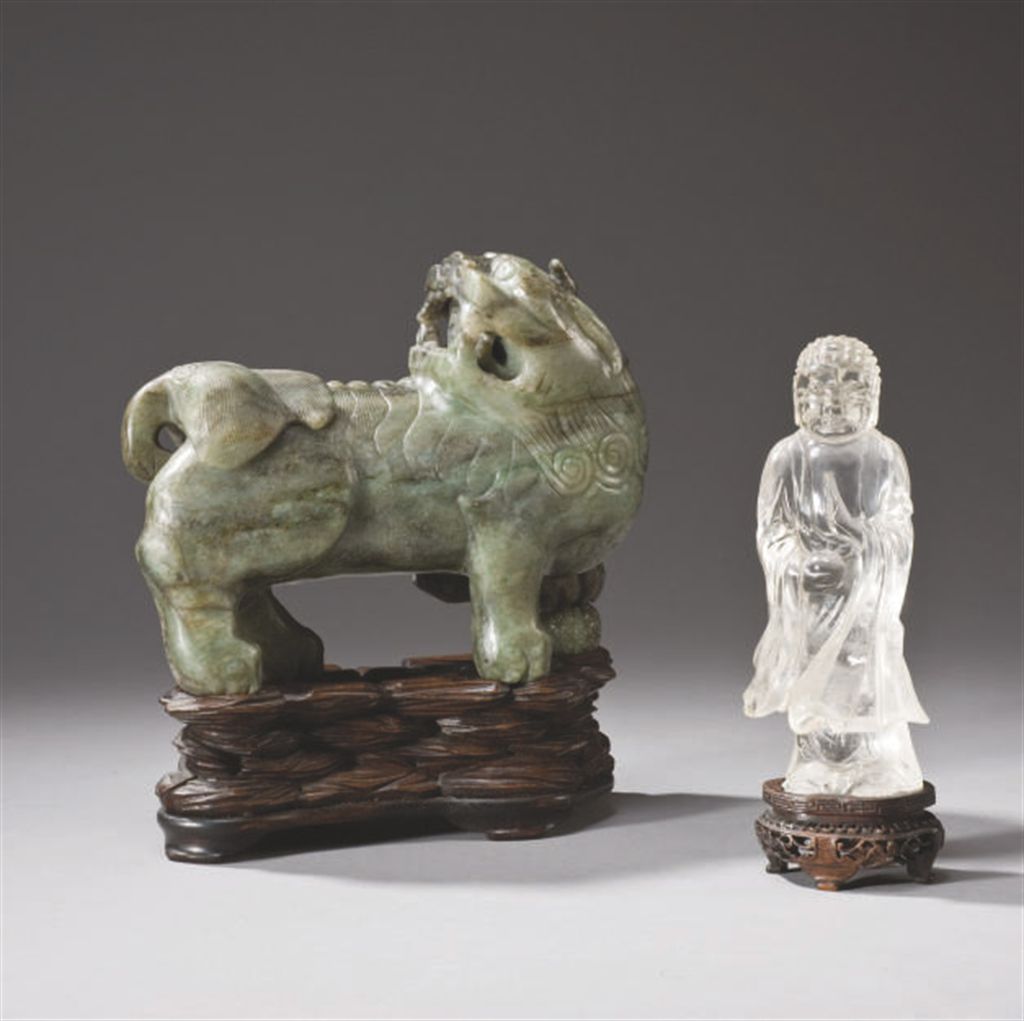

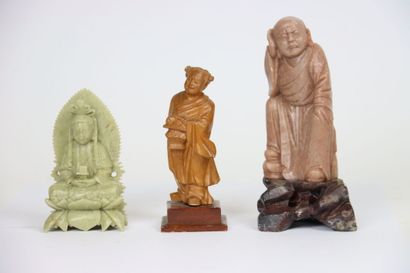

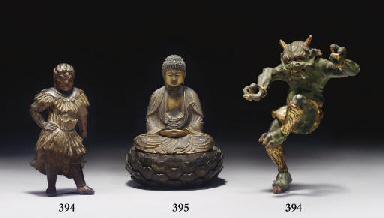






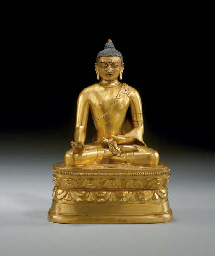
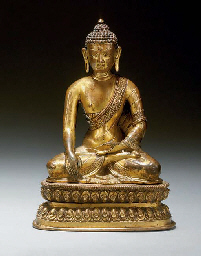
Testen Sie LotSearch und seine Premium-Features 7 Tage - ohne Kosten!
Lassen Sie sich automatisch über neue Objekte in kommenden Auktionen benachrichtigen.
Suchauftrag anlegen